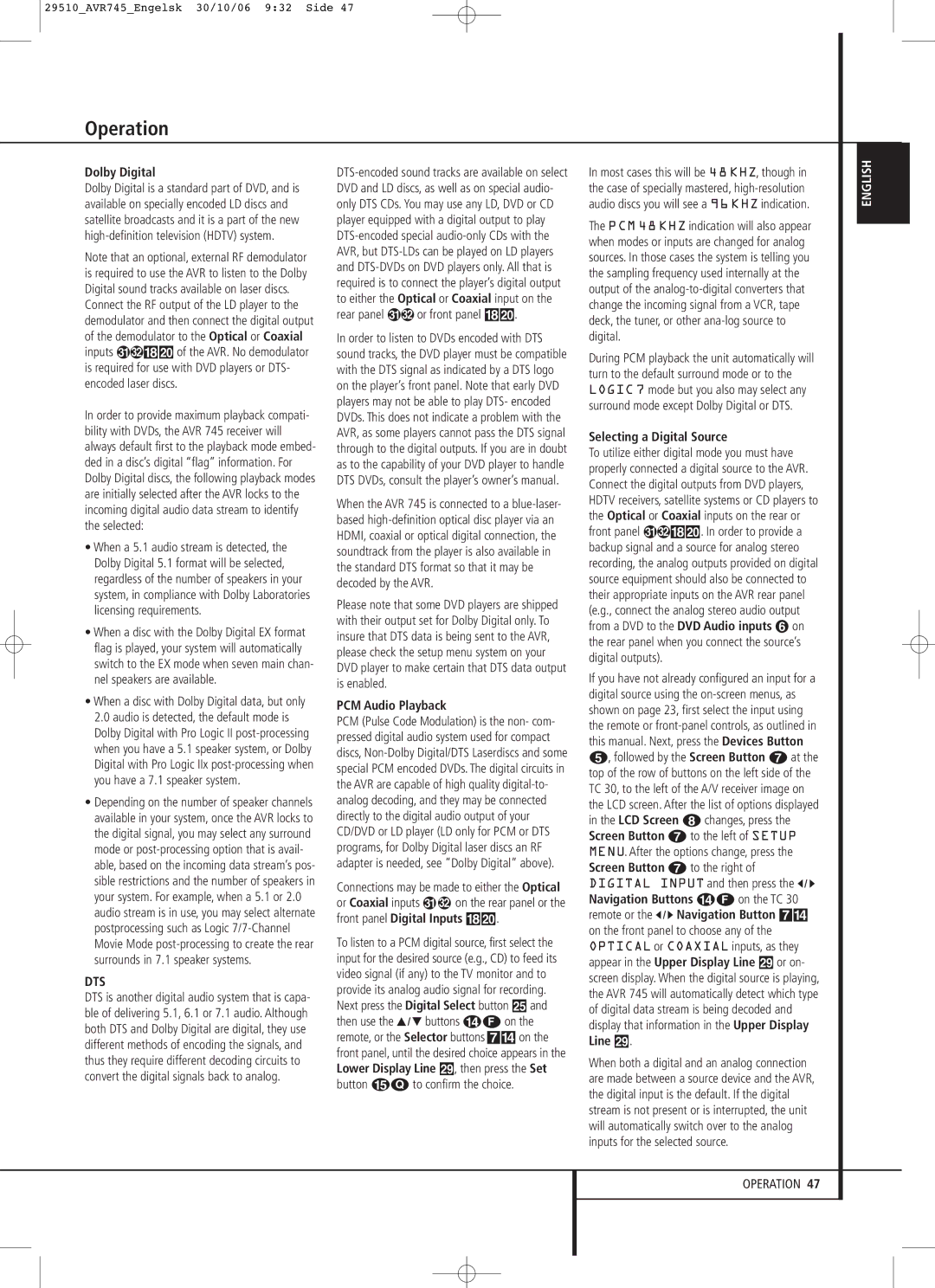
29510_AVR745_Engelsk 30/10/06 9:32 Side 47
Operation
Dolby Digital
Dolby Digital is a standard part of DVD, and is available on specially encoded LD discs and satellite broadcasts and it is a part of the new
Note that an optional, external RF demodulator is required to use the AVR to listen to the Dolby Digital sound tracks available on laser discs.
Connect the RF output of the LD player to the demodulator and then connect the digital output of the demodulator to the Optical or Coaxial
inputs *Ó of the AVR. No demodulator is required for use with DVD players or DTS- encoded laser discs.
In order to provide maximum playback compati- bility with DVDs, the AVR 745 receiver will always default first to the playback mode embed- ded in a disc’s digital “flag” information. For Dolby Digital discs, the following playback modes are initially selected after the AVR locks to the incoming digital audio data stream to identify the selected:
•When a 5.1 audio stream is detected, the Dolby Digital 5.1 format will be selected, regardless of the number of speakers in your system, in compliance with Dolby Laboratories licensing requirements.
•When a disc with the Dolby Digital EX format flag is played, your system will automatically switch to the EX mode when seven main chan- nel speakers are available.
•When a disc with Dolby Digital data, but only 2.0 audio is detected, the default mode is Dolby Digital with Pro Logic II
•Depending on the number of speaker channels available in your system, once the AVR locks to the digital signal, you may select any surround mode or
DTS
DTS is another digital audio system that is capa- ble of delivering 5.1, 6.1 or 7.1 audio. Although both DTS and Dolby Digital are digital, they use different methods of encoding the signals, and thus they require different decoding circuits to convert the digital signals back to analog.
rear panel | or front panel *Ó. |
In order to listen to DVDs encoded with DTS sound tracks, the DVD player must be compatible with the DTS signal as indicated by a DTS logo on the player’s front panel. Note that early DVD players may not be able to play DTS- encoded DVDs. This does not indicate a problem with the AVR, as some players cannot pass the DTS signal through to the digital outputs. If you are in doubt as to the capability of your DVD player to handle DTS DVDs, consult the player’s owner’s manual.
When the AVR 745 is connected to a
Please note that some DVD players are shipped with their output set for Dolby Digital only. To insure that DTS data is being sent to the AVR, please check the setup menu system on your DVD player to make certain that DTS data output is enabled.
PCM Audio Playback
PCM (Pulse Code Modulation) is the non- com- pressed digital audio system used for compact discs,
Connections may be made to either the Optical
or Coaxial inputs on the rear panel or the front panel Digital Inputs *Ó.
To listen to a PCM digital source, first select the input for the desired source (e.g., CD) to feed its video signal (if any) to the TV monitor and to provide its analog audio signal for recording. Next press the Digital Select button Û and then use the ⁄ / ¤ buttons DF on the remote, or the Selector buttons 7$ on the front panel, until the desired choice appears in the Lower Display Line ˜, then press the Set button EQ to confirm the choice.
In most cases this will be 48 KHZ, though in the case of specially mastered,
The PCM 48 KHZ indication will also appear when modes or inputs are changed for analog sources. In those cases the system is telling you the sampling frequency used internally at the output of the
During PCM playback the unit automatically will turn to the default surround mode or to the LOGIC 7 mode but you also may select any surround mode except Dolby Digital or DTS.
Selecting a Digital Source
To utilize either digital mode you must have properly connected a digital source to the AVR. Connect the digital outputs from DVD players, HDTV receivers, satellite systems or CD players to the Optical or Coaxial inputs on the rear or
front panel *Ó. In order to provide a backup signal and a source for analog stereo recording, the analog outputs provided on digital source equipment should also be connected to their appropriate inputs on the AVR rear panel (e.g., connect the analog stereo audio output from a DVD to the DVD Audio inputs on the rear panel when you connect the source’s digital outputs).
If you have not already configured an input for a digital source using the
When both a digital and an analog connection are made between a source device and the AVR, the digital input is the default. If the digital stream is not present or is interrupted, the unit will automatically switch over to the analog inputs for the selected source.
ENGLISH
OPERATION 47
